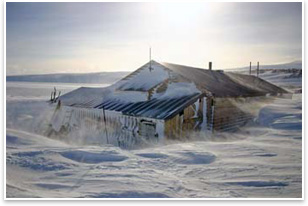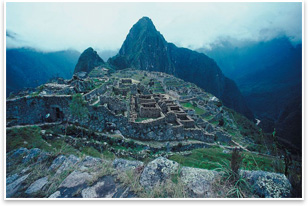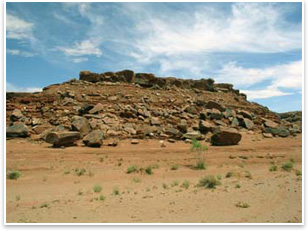| |
WMF 100 Most Endangered Includes Machu Picchu, New Orleans, and Scott’s Hut, Antarctica
Summary: The World Monuments Fund on June 7 announced its biennial list of the 100 most endangered sites around the globe, highlighting three critical human-generated threats: political conflict, unchecked urban and industrial development, and, for the first time, global climate change. The Watch List, assembled by an international panel of experts in archaeology, architecture, art history, and preservation, is for many of the sites the best, and sometimes the only hope for survival.
Global climate change
The 2008 Watch List includes a number of sites threatened by global warming, including:
- Herschel Island, Canada, home to ancient Inuit sites and a historic whaling town at the edge of the Yukon that are being lost to the rising sea and melting permafrost in this fastest-warming part of the world
 Scott's Hut, Antarctica, a time-capsule of early twentieth-century exploration, which, ironically, is being engulfed by vastly increased snowfall, possibly a result of changes in the climate, which the station was built to monitor (Photo right) Scott's Hut, Antarctica, a time-capsule of early twentieth-century exploration, which, ironically, is being engulfed by vastly increased snowfall, possibly a result of changes in the climate, which the station was built to monitor (Photo right)- Chinguetti Mosque, Mauritania, located in one of Islam's seven holy cities and one of many sites in West Africa endangered by the encroaching desert
- Sonargaon-Panam City, Bangladesh, a former medieval trading hub and crossroads of culture, whose long-neglected and deteriorating architecture is increasingly threatened by flooding in this low-lying country, one of the most vulnerable to the impacts of global warming
- Leh Old Town, Ladakh, India, a rare intact medieval city in the Himalayan region, now trying to balance development and modernization with sustainability as its traditional architecture faces changing weather patterns, including heavy rains, that it was not built to withstand
- New Orleans, whose historic neighborhoods, already pummeled by Hurricane Katrina, are now struggling to restore homes while also preparing for future challenges posed by rising sea levels and the likelihood of stronger storms.
Conflict
Whether past, ongoing, or imminent, conflict has become one of the most severe threats to cultural heritage. Examples include:
- Cultural Heritage Sites of Iraq, where ongoing conflict has led to catastrophic loss at the world's oldest and most important cultural sites, and where the damage continues
- Bamiyan Buddhas, Afghanistan, tragic illustrations of the importance of cultural heritage and the consequences of its destruction, the leftover fragments and historic context remain endangered, and their future in question
 Church of the Holy Nativity, Bethlehem, Palestinian Territories, the site of one of Christianity's oldest churches, now deteriorating as a result of modern political tensions (Photo right) Church of the Holy Nativity, Bethlehem, Palestinian Territories, the site of one of Christianity's oldest churches, now deteriorating as a result of modern political tensions (Photo right)- Famagusta Walled City, Cyprus, featured in Shakespeare's Othello, now neglected as political deadlock over the island's sovereignty continues
- Sarajevo City Hall, Bosnia and Herzegovina, an architectural testament to the cultural diversity of the city, damaged by war
- Srinigar Heritage Zone, India, where traditional structures built to survive earthquakes are suffering as a result of ongoing instability and conflict in the Kashmir region
- Freetown Historic Monuments, Sierra Leone, a city, once known as the "Athens of West Africa," emerging from protracted civil war and now seeking to protect and preserve the monuments that played a part in its history, including one of the most important sites related to slavery on the continent.
Economic and development pressures
New construction often means destruction of historic places, and the Watch List of sites facing encroachment or outright destruction, includes:
- Tara Hill, Ireland, a sacred landscape at the very heart of historic Ireland, now threatened by a highway meant to ease the commute from Dublin
- Rock art at Dampier, Australia, and Macusani-Corani, Peru, where millennia of history are threatened by industrial developments that will be gone in decades
 Machu Picchu, Peru, one of the world's greatest treasures, once an isolated sanctuary, is already endangered by unchecked and unmanaged tourism and now further threatened by plans for even greater access to the site, with no greater protection (Photo right) Machu Picchu, Peru, one of the world's greatest treasures, once an isolated sanctuary, is already endangered by unchecked and unmanaged tourism and now further threatened by plans for even greater access to the site, with no greater protection (Photo right)- St. Petersburg Skyline, Russia, a center of architectural achievement in Russia, now the proposed location for an enormous Gazprom skyscraper that will forever change it
- Old Damascus, Syria, one of the oldest continually occupied urban centers on Earth, is seeing its remarkable historic center abandoned and demolished to make way for modern construction
- Hasankeyf, Turkey, where a dam that will be used for half a century will flood a site that was already ancient when Alexander the Great conquered the known world.
Sites in the U.S. include:
 Tutuveni Petroglyph Site, Hopi Tribal Land, Arizona, a unique collection of Hopi clan symbols carved into rock, this key to Native American language and culture—described as the "Rosetta Stone" of Hopi civilization—is being vandalized into oblivion (Photo right) Tutuveni Petroglyph Site, Hopi Tribal Land, Arizona, a unique collection of Hopi clan symbols carved into rock, this key to Native American language and culture—described as the "Rosetta Stone" of Hopi civilization—is being vandalized into oblivion (Photo right) - New York State Pavilion, Queens, New York, often the first monument seen by visitors to New York City—on the way into town from LaGuardia Airport—the New York State Pavilion is one of the few remaining structures built for the 1964 World's Fair. An icon to some, an eyesore to others, this remarkable complex, including the "Tent of Tomorrow" is endangered by neglect and indifference as much as by rust
- Historic Route 66, once the only year-round route to the West Coast, this highway evolved into an iconic getaway route, dotted with whimsical architecture and amusements as the American road trip became a right of passage; now a pilgrimage route for modern travelers, the beloved sites along Route 66 are deteriorating and need protection
- Main Street Modern, once symbolizing ideals of progress and democracy, and the forward-looking philosophy of the post-War era, the civic buildings of American towns—libraries, schools, town halls—were designed in the Modern style. Now perceived as outdated or even old fashioned, these buildings are being demolished at an alarming rate, putting an entire corpus of important architecture in America at risk of disappearing
- The Salk Institute, La Jolla, Calif., its iconic view of the Pacific Ocean is threatened by new construction at the end of its central courtyard.
|
|


 Scott's Hut, Antarctica,
Scott's Hut, Antarctica, Church of the Holy Nativity, Bethlehem, Palestinian Territories,
Church of the Holy Nativity, Bethlehem, Palestinian Territories, Machu Picchu, Peru,
Machu Picchu, Peru, Tutuveni Petroglyph Site, Hopi Tribal Land, Arizona,
Tutuveni Petroglyph Site, Hopi Tribal Land, Arizona,